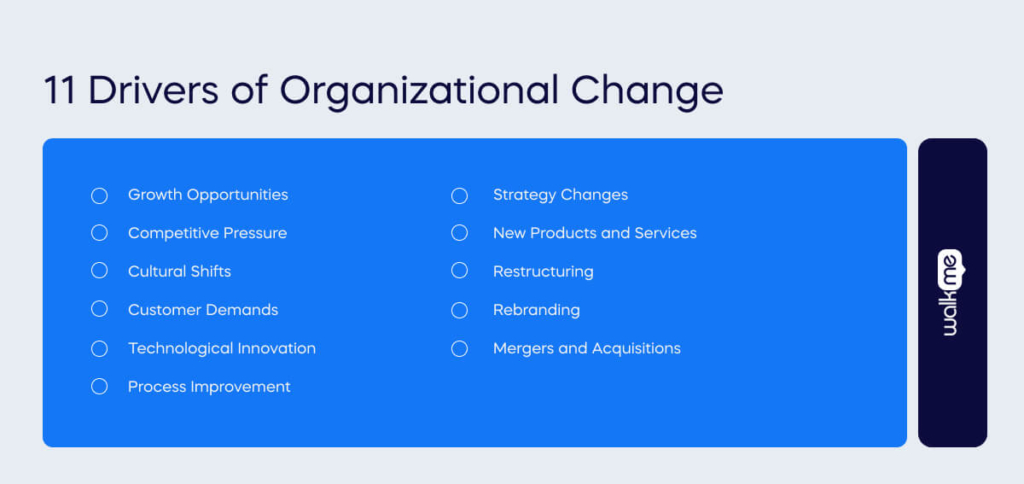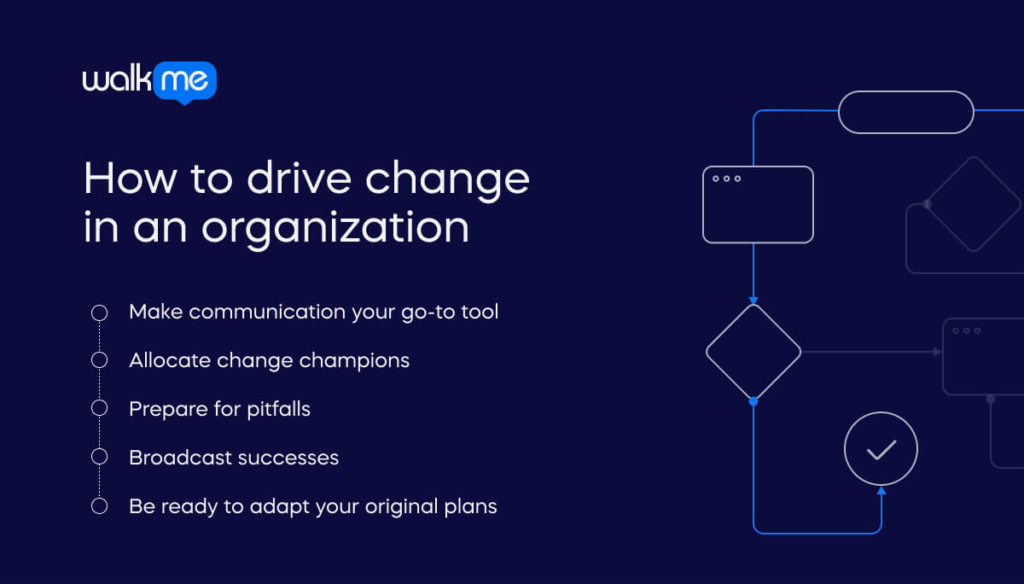The best way to drive change is through understanding it as deeply as possible.
Organizational change, the large-scale changes you make to your organization to improve operational efficiency and optimize business processes for higher revenue, requires many factors to drive it.
Increasing the understanding of change throughout an organization also streamlines the change management process, as fear of the unknown is one of the biggest causes of change resistance.
By understanding each organizational change driver, you can increase your chances of success and effective organizational alignment.
Understanding these drivers can help you drive productivity by 63% as you achieve a successful change initiative within your digital transformation.
To help you understand organizational change drivers, we will explore the following topics:
- What are organizational change drivers?
- The nature of organizational change vs. change drivers
- Eleven drivers of organizational change
- How to drive change in an organization
What are organizational change drivers?
Organizational change drivers are factors that determine how likely an initiative is to succeed and help you manage change better throughout your organization.
By understanding each organizational driver of change, you can more easily tackle the complex, ever-changing challenges of organizational change throughout the change process, unlocking a competitive advantage.
Things become simpler as you understand how change works and all its complexities and, crucially, why employees struggle to accept the transition and avoid change fatigue.
What are the two types of organizational change drivers?
The two types of organizational change drivers are transformational and transitional.
- Transformational drivers revolutionize the company. Examples include Intelligent Information Management (IIM) and Digital Transformation initiatives, which completely overhaul how a company operates and processes information.
- Transitional drivers modify or replace current elements within the company. This often requires employees to emotionally let go of previous methods and adapt to new procedures.
Understanding these two types of change drivers can enable you to categorize the forces affecting your organization and develop more effective strategies for managing change efficiently.
The Nature of Organizational Change vs. Change Drivers
In many cases, a single root cause—or a set of causes—drives an organization’s change.
Various internal and external factors can trigger a change in your enterprise.
For instance, competitive pressure may spur the implementation of a new software application.
Comparing the nature of organizational change and its drivers can help you understand the causes that drive change, supporting your progression to success.
See the table below to compare the differences between these two aspects of change.
Nature of organizational change
Organizational change is inherently dynamic and multifaceted, characterized by several key aspects that shape its nature and impact on an organization.
1. Continuous: It is an ongoing process rather than a one-time event.
2. Complex: The interplay of various factors adds complexity to your company’s changes.
3. Multidimensional: It simultaneously affects various dimensions of an organization.
4. Disruptive: Change disrupts the established status quo within an organization.
5. Contextual: Each organization’s unique context shapes the nature of change.
6. Strategic: Often, this type of change is driven by strategic considerations, aligning with the organization’s vision, goals, and long-term objectives.
Change drivers
Various internal and external factors can trigger a change in your enterprise.
Common causes include:
1. External influences: Changes in the external environment prompt organizations to adapt for competitiveness.
2. Competitive pressures: Intense industry competition or new market players drive organizations to implement changes.
3. Organizational growth or decline: Significant changes in size necessitate organizational adjustments.
4. Technological advancements: Rapid technological progress can catalyze organizational change.
5. Mergers and acquisitions: Changes are often required during organizational mergers, acquisitions, or partnerships.
6. Internal inefficiencies or performance gaps: Identifying areas for improvement drives organizational changes.
Consider the differences and similarities between the nature of organizational change and change drivers to help you conceptualize the bigger picture of how to respond to change drivers using your knowledge of the nature of the changes you want to achieve.
11 Drivers of Organizational Change

Below, we will examine eleven different drivers that promote organizational transition, but remember that some of these are root causes.
An opportunity for growth, for instance, is a root driver of change.
However, some of the others covered here – such as rebranding or restructuring – can be two things at once: a type of organizational change and a driver of change.
First, let’s look at some common root causes of organizational change.
1. Growth Opportunities
Growth opportunities are a major driver of organizational change, and in today’s digital market, this is no surprise.
The online economy has opened up countless new opportunities for growth, including:
- New markets.
- Innovative products.
- New business processes and practices.
2. Competitive Pressure
Many people and organizations resist change only when they feel it is essential.
And one thing that pushes people to change is competitive pressure.
This pressure can come from bigger competitors, digital disruptions, new products, etc.
3. Cultural Shifts
An organization can influence Business cultures deliberately, or these changes can occur naturally.
When cultural shifts occur organically, then organizations must respond to those shifts.
For instance, with every generation, cultures change.
These changes demand new workflows, processes, work environments, communication strategies, etc.
As with every other change driver covered here, the nature of the change will depend on the root cause of that change.
4. Customer Demands
Customer demands can also fuel organizational changes.
New buying habits, audience sophistication, and new technologies can all pressure an organization to make changes.
Those change projects can include everything from new products to new marketing approaches.
Emphasize this driver to your staff. ‘ Customer is king’ campaigns can lead to success, as the culture tries to put customers at the forefront of all decisions and interactions.
5. Technological Innovation
Today, technology itself is a major driver of change.
The fast-paced digital marketplace is fueling digital transformation across industry after industry.
The internet, for instance, has spurred the growth of countless markets, channels, and new economies.
Another example is how generative AI has completely shaken up automation and made many customer service applications previously unavailable.
To remain competitive, it’s essential to respond to these change drivers positively and with an open mind.
6. Process Improvement
Another basic reason to change is process efficiency.
Inefficiencies can stem from many causes, such as:
- Ineffective communication.
- Poor teamwork.
- Outdated software.
- Inefficient procedures.
Likewise, process improvements can come in many forms, from digital adoption to procedural changes.
7. Strategy Changes
A shift in an organization’s strategy can easily result in organizational change programs.
For instance, organizations that adopt a digital-first business strategy will likely undertake various digital transformation initiatives.
A company emphasizing a customer-centric strategy will initiate several transformations to its customer-facing business functions.
8. New Products and Services
Like many of the other change drivers covered here, new products and services can result from other causes.
And they can also fuel other changes.
For instance, customer demand may push a company to create a new product.
That decision, in turn, can cause a business to engage in other change programs, such as structural changes, strategic shifts, and so on.
9. Restructuring
Organizational restructuring can involve:
- Reshuffling management.
- Changing job duties, roles, or responsibilities.
- Relocation.
Any time a business is restructured, it often involves—and fuels—other changes, such as changes to procedures, processes, and culture.
10. Rebranding
Rebranding is another type of change that can drive other changes.
It can fuel:
- Cultural shifts.
- Changes to customer service.
- Shifts in PR strategies.
- Changes to marketing strategies.
11. Mergers and Acquisitions
Mergers and acquisitions are often large-scale, impactful changes that drive:
- Restructuring.
- Changes to processes and procedures.
- Cultural changes.
These complex changes are often driven by other high-level causes rooted in business strategy, the business environment, etc.
How to drive change in an organization

The next step is to consider how to drive change in your organization. There are many effective ways to achieve this, as shown in the list below.
Make communication your go-to tool.
When implementing change, leaders must proactively communicate with the organization. The magnitude of the change dictates the strategic nature of the communication plan.
Timing is crucial; communicating too early may cause unnecessary worry while waiting until the last minute can catch people off-guard. Identify who needs to know what and when.
Allocate change champions
Support is crucial for successful change at all organizational levels, not just from top leaders. People are more inclined to embrace change if their colleagues do.
It is vital to engage champions across all levels. Conduct focus group meetings to gather feedback and address potential challenges seriously.
Prepare for pitfalls
Change inevitably comes with an adjustment period and potential challenges. Anticipate negative aspects, brainstorm solutions in advance, and avoid being unprepared.
While it’s impossible to predict every obstacle, thoughtful preparation beforehand can alleviate future difficulties and ensure a smoother implementation of the change effort.
Broadcast successes
After implementing a change, celebrate its success by highlighting the positives. If the change was challenging and involved a complete overhaul of your company structure, emphasize the benefits it has brought.
Be creative in describing various aspects of the change to ensure its positive impact is recognized, especially if the transition is difficult.
Be ready to adapt your original plans.
An idea remains theoretical until executed in reality. Leaders must be adaptable and ready to make adjustments.
Consider starting with a small segment as a pilot before organization-wide implementation.
Evaluate what works and what doesn’t, then make necessary tweaks for a successful rollout.
Educate your staff on drivers of change in the workplace
Educating your staff on workplace change drivers is essential to foster adaptability in an environment where change is part of the daily routine and drives every department’s business processes.
Within the organizational change training you offer, equip staff with insights into internal and external drivers of change, such as digital technologies, market dynamics, and strategic shifts.
By enhancing their understanding, you empower your team to independently identify the potential factors that drive change from within an organization.
Understanding what drives organizational change allows them to navigate change initiatives with resilience, contributing to a more agile and successful workplace filled with openness toward change and a culture of new ideas.
FAQs
By proactively identifying potential sources of resistance—such as fear of job displacement or lack of understanding—organizations can develop targeted communication and training strategies to address concerns and foster acceptance.
Continuous learning enables employees to adapt to evolving technologies and processes, ensuring sustained engagement and minimizing disruption during transformation initiatives.
Engaging stakeholders early in the change process promotes transparency, builds trust, and encourages collaborative problem-solving, leading to more effective and accepted transformations.
Addressing cultural barriers requires assessing organizational values and behaviors, then implementing change management strategies that align transformation goals with the existing culture or gradually evolve it to support new initiatives.

